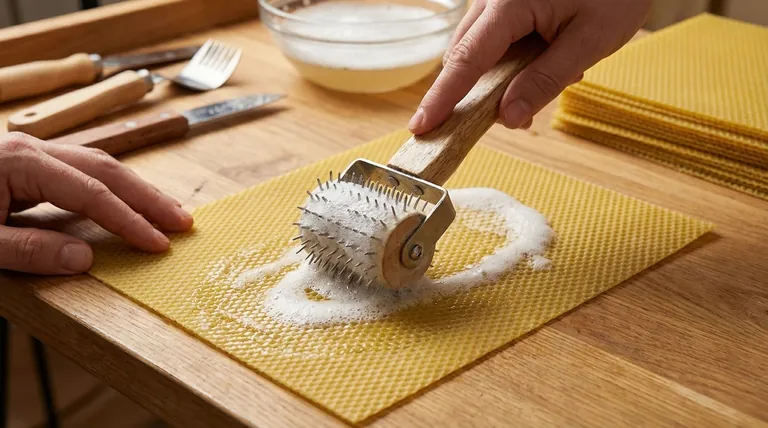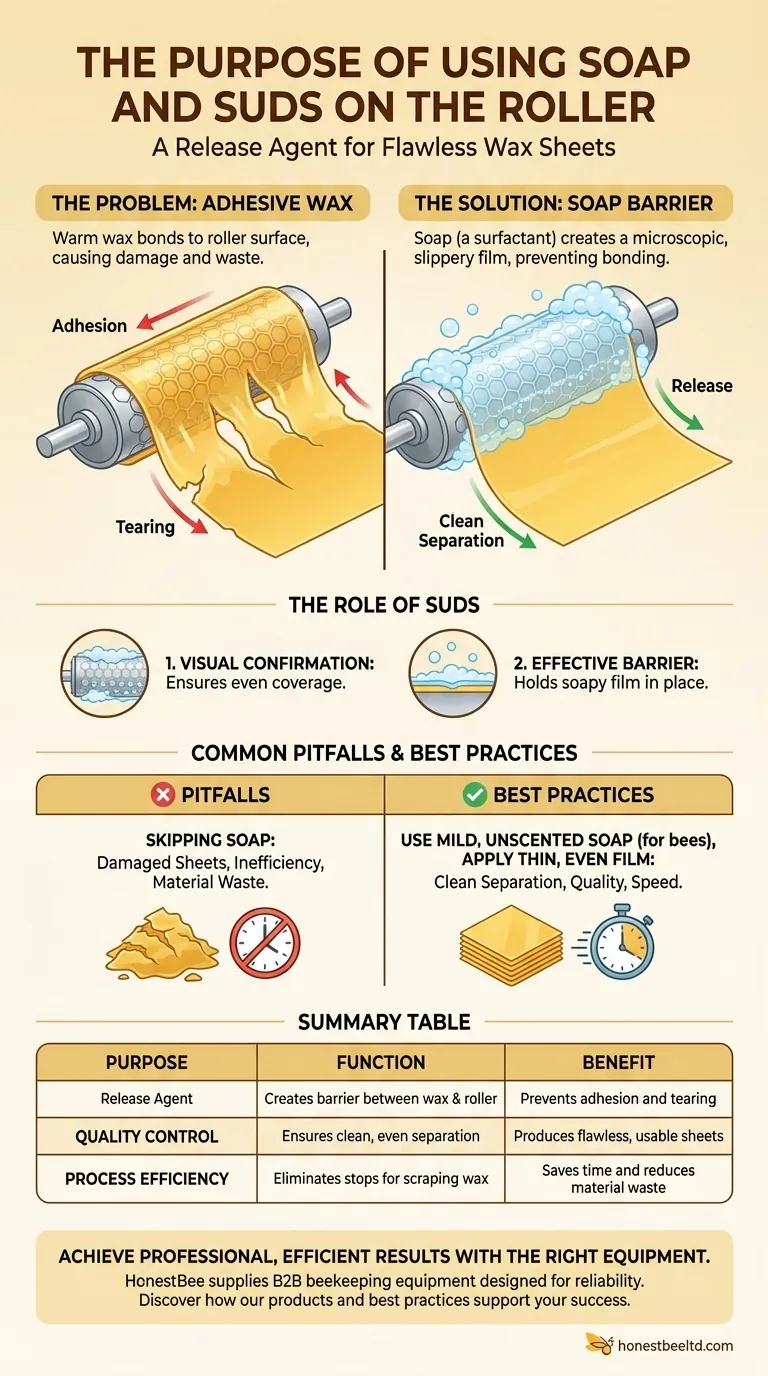The primary purpose of using soap and suds on a roller is to act as a release agent. This thin, soapy film creates a barrier that prevents the warm, sticky wax from adhering to the roller's surface, ensuring that the finished wax sheets can be removed cleanly and without tearing.
At its core, this practice is not just about lubrication; it is a critical step in quality control. Applying soap and suds is the simplest and most effective way to guarantee a clean separation between your material and your equipment.

The Problem: Why Wax Sticks
Wax, especially when warmed to a pliable state for rolling, is naturally adhesive. Understanding this property is key to understanding why a release agent is necessary for a smooth process.
The Adhesive Nature of Wax
When you roll wax, you are applying pressure that forces it into the fine details of the roller's surface. The warm wax molecules have a tendency to bond with the metal or plastic of the roller, creating a strong adhesive connection.
The Impact of Surface Tension
Without a barrier, the wax will stick unevenly across the roller. As the roller turns, this adhesion will pull, stretch, and ultimately tear the delicate sheet you are trying to form.
How Soap Solves the Adhesion Problem
Soap is a surfactant, meaning it has a unique molecular structure that reduces surface tension between liquids and solids. This property makes it an ideal release agent in this context.
Creating a Microscopic Barrier
When you apply soap and water to the roller, you create an ultra-thin, slippery film. This film sits between the roller's surface and the wax, physically preventing the wax from making direct contact and bonding with the roller.
The Role of Suds
The suds, or lather, serve two practical purposes. First, they are a visual confirmation that the soap solution is present and evenly distributed across the entire surface of the roller. Second, the suds help hold the soapy water in place, ensuring the barrier remains effective during rolling.
Common Pitfalls and Best Practices
Failing to use a release agent is the most common mistake, but the way you use it also matters. The goal is to create a flawless sheet, and that requires proper technique.
Consequence 1: Damaged or Unusable Sheets
The most immediate consequence of skipping the soap is product failure. The wax will adhere firmly to the roller, resulting in torn, stretched, and completely unusable sheets.
Consequence 2: Process Inefficiency
If wax sticks, you must stop the process to scrape it off the roller. This is time-consuming, frustrating, and leads to significant material waste. A continuous, efficient workflow is impossible without a good release agent.
Best Practice: Use a Mild, Unscented Soap
For applications like beekeeping, where the wax foundation will be introduced to a hive, it is critical to avoid contamination. Use a mild, natural, and unscented soap to prevent introducing foreign chemicals or smells that could harm or repel the bees.
Best Practice: Apply a Thin, Even Film
The goal is a slippery surface, not a soaking wet one. Too much water can cool the wax prematurely or create imperfections in the sheet. Apply a thin, consistent layer of suds just before the wax makes contact with the roller.
Making the Right Choice for Your Goal
Properly using a release agent is fundamental to the success of your project. Your primary goal will determine how you view this essential step.
- If your primary focus is high-quality output: Treat the application of soap as a non-negotiable step for achieving perfectly formed, defect-free wax sheets every time.
- If your primary focus is efficiency and speed: View the soap as a critical time-saving tool that prevents frustrating stops, difficult cleanup, and wasted material.
This simple technique is the key to transforming a difficult task into a smooth and professional process.
Summary Table:
| Purpose | Function | Benefit |
|---|---|---|
| Release Agent | Creates a barrier between wax and roller | Prevents adhesion and tearing |
| Quality Control | Ensures clean, even separation | Produces flawless, usable sheets |
| Process Efficiency | Eliminates stops for scraping wax | Saves time and reduces material waste |
Achieve professional, efficient results with the right equipment and supplies.
Struggling with wax sticking to your rollers? HONESTBEE supplies commercial apiaries and beekeeping equipment distributors with high-quality, wholesale beekeeping supplies designed for reliability and efficiency. Our equipment, combined with best practices like using a proper release agent, helps you produce perfect wax sheets every time, minimizing waste and maximizing your productivity.
Contact HONESTBEE today to discuss your wholesale supply needs and discover how our products can support your success.
Visual Guide

Related Products
- Professional Honey Uncapping Roller for Efficient Harvesting
- HONESTBEE 72 Frame Industrial Electric Honey Extractor for Beekeeping
- Electric Honey Press Machine for Squeezing Honey Comb Press Equipment
- Stainless Steel Manual Honey Press with Guard for Pressing Honey and Wax
- Honey Wax Separating Wax Press with Metal Screw Wax Separator Machine
People Also Ask
- What is an uncapping fork? A Precision Tool for Efficient Honey Harvesting
- What is an uncapping roller? The Essential Tool for Bee-Centric Beekeepers
- What is the best method for uncapping honey? A Guide to Speed vs. Comb Preservation
- What are the benefits of using an uncapping roller? Save Bee Energy and Boost Hive Productivity
- What is an electric heating honey scraper and how does it work? Streamline Your Honey Harvest



















